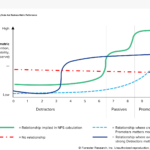RevOps teams are at the heart of driving growth and efficiency. Despite being champions of AI-enabled tools to make that happen, they often end up like the cobbler’s children with no shoes and come last in adopting the latest tools themselves. At the same time, most revenue teams in B2B organizations are leveraging AI and many plan to make more use of AI in their marketing going forwards. In reality, the total may even be higher given that AI is invisibly embedded in many tools and platforms without it even being realized. The explosion in adoption of “visible” AI has come since the launch of ChatGPT 3.5 in late 2022 and that tends to centre primarily around content generation use cases. (The clue’s in the name, “Generative Pretrained Transformer”.)
There’s more to AI than generative though. At Forrester, we see five categories of AI capabilities that are applied and combined to solve a broad range of go-to-market challenges spanning automation, perceptive, predictive, and prescriptive, along with generative. While we hear a lot about the application of these AI capabilities in sales and marketing, what are the use cases from the perspective of revops professionals? With its focus on data, process, efficiency, and more, how can revops leverage these technologies to improve its own performance and deliver even more value across the revenue ecosystem?
Harness AI And Drive Revops Value Delivery
There are plenty of options for revops teams to leverage AI:
- Analytics. A key responsibility for many revops teams, analytics represents fertile territory for the adoption of AI. A skilful analyst will rapidly identify patterns, build segments, identify personas and generate many more actionable insights. Similarly, AI models make possible advanced predictive analytics that highlight likely future outcomes, patterns and risks, supporting planning and decision making. AI also makes sophisticated visualization a snap, including charts, customer journey maps and interactive dashboards.
- Workflow automation. Here AI offers to streamline and automate routine and recurring tasks that save revops teams time and free them for more value-added activities. This might include assessing and routing incoming requests, perhaps even creating an initial requirements document and responding with requests for further information to complete the request. AI will also automatically generate reports on in-flight and completed tasks to monitor throughput and highlight bottlenecks, and suggest improvements to streamline operations.
- Data governance. Aspects of machine learning and algorithmic processing have long been employed by data quality tools. The recent advances in AI mean these tools are now even smarter in identifying and fixing a range of data anomalies. AI also has a role in unifying audience identities, combining profiles and associated signals that are crucial to understand who is in market and then take appropriate action. This cuts two ways though as data quality is a primary factor limiting genAI adoption.
- Revenue process enhancements. Go-to-market teams are always looking for ways to improve core revenue processes, and they can lean on AI capabilities across the revenue technology stack to help. AI can analyse vast amounts of customer data, including demographics, behaviour, and interaction history, to generate opportunity propensity scores that guide sales and marketing efforts to the most promising prospects. When looking at signals processing, AI can monitor customer interactions and sales data, identify patterns, and alert revenue teams when a customer is likely to churn or present expansion opportunities. New AI capabilities on the market also help organizations identify and complete buying groups.
- Campaign optimization. Revops teams can use AI to unlock more success with campaigns. AI can manage multi-variate testing, looking at the performance of different combinations of campaign elements, channels, and timing and provide insights on the best performing combinations. For more accurate target audiences, revops teams can use AI’s ability to combine market intelligence and customer data to organize it into segments with similar attributes and high propensity to buy. AI can also continuously monitor campaign performance and provide real-time analytics and insights, helping marketers track KPIs and make data-driven decisions.
Lead The AI Adoption Charge
In addition to driving adoption of AI across the revenue ecosystem, revops must embrace the technology for its own purposes. Don’t be cobblers’ children and go barefoot while everybody else sports the best shoes! In approaching any AI endeavour, be it within revops or the wider revenue ecosystem, the first step is to ensure that the goal of the initiative is clear and focused on meeting business objectives. Experimentation is fine, as long as there is a hypothesis by which to judge the outcome in a way that is meaningful to the organization. Then, assess existing technology, AI adoption, processes, data and skills to determine what is needed to reach the goal. Finally, add the intended developments to your roadmap and share this widely so that stakeholders have visibility over planned AI deliverables. Don’t forget to consider privacy and security compliance at all times. Whatever happens, keep experimenting!








